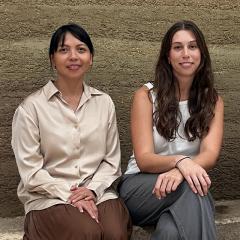Paul Dielemans has accomplished a fascinating PhD thesis that explores the 1940–50s school designs of Queensland architect Frank Leo Cullen (1909–91) and what they represented for the Roman Catholic Church.
Titled Why Go Modern? The Catholic School Designs of Frank L. Cullen, Dr Dielemans’ thesis was conferred by the School of Architecture, Design and Planning on 8 August 2024.
“My work draws together interwar architecture and its reception in Australia, education theory and early modern architectural practice, and Catholic education and theological thinking – which are all linked by the ‘moderately modern’ school designs of Frank Cullen,” Dr Dielemans says.
“Completing my PhD thesis has given me the satisfaction that I have contributed new knowledge and ideas to a number of disparate interdisciplinary views.”

The thesis focuses on eighteen schools designed in a “moderately modern” version of an Interwar Functionalist architectural style by Frank Cullen for the Roman Catholic Church in Queensland. It investigates how the modern appearance of Cullen’s Functionalist schools was linked to the secular education that Catholic schools provided – the buildings effectively functioning as billboards to build public awareness and support for the Church’s claim for government funding for their primary and secondary schools. For a time, the modern school designs of the Catholic Church led the State Department of Works, and Cullen’s Functionalist schools helped enable the dissemination of Modernism/Functionalism in Queensland.
“Nothing was previously written about Frank Cullen's oeuvre, especially his modern school designs, and no link had ever been made about the appearance of his school designs in the 1940s–50s and what they represented for the Catholic Church,” Dr Dielemans says.
“The other interesting fact is that the historiography of architectural Modernism has excluded the middle-of-the-road modernism, such that there is a research vacuum on ‘moderately modern’ architecture that was readily and widely accepted by the everyman above that of the elitist avant-garde cognoscenti.”
Dr Dielemans says one of the aspects he enjoyed most about completing his PhD research in the School of ADP was having the time to explore his subject broadly. He learnt not only about modern interwar architecture, but also about differing education systems in Australia, England and Europe, the difficulty experienced by people living in the Depression era in Brisbane, the oppression experienced by the Irish during English occupation, and early Australian convict and Catholic Church history.
“It has been an enriching experience,” he says.

From the very beginning of his studies, Dr Dielemans has maintained a broad curiosity about the world surrounding him. After completing his undergraduate studies in geology with an honours thesis on volcanology more than forty years ago, he went on to work in gold exploration and mining. Further studies in zoology and environmental science led him to work as an environmental advisor in the mining industry, and a lifetime interest in photography, ultimately specialising in architectural photography, laid a pathway to architectural history.
“My advice for other higher degree by research candidates it to be open to the universe and nurture your curiosity. Be brave enough to spend time exploring semi or unrelated areas of interest as learning comes from a variety of fields and a whole host of sources, be they in books, electronic media, and the people you engage with professionally, informally or as friends.”
So, what’s next? Dr Dielemans would like to publish chapters from his thesis, “as well as chapters that were excluded from it … Particularly those showing the importance of Frank Cullen to Archbishop James Duhig's building campaign,” he says.
“And additionally, how the Catholic Church was developing ideas that paralleled town planning theory that advocated the school as the nucleus of a community neighbourhood hub in an urban context, and how the establishment of Catholic parishes assisted post-war building boom and expansion of the suburbs.”
Dr Dielemans hopes to add documentation for the Cullen practice to the Digital Archive of Queensland Architecture, to highlight the large body of secular work in addition to religious buildings that the practice was known for. He also intends to promote the heritage values of the buildings designed by Cullen, many of which have been demolished or unsympathetically altered.
Publishing two sets of extra curricula research is also on his list: one on some interesting early Queensland photographers from the 1800s–1900s with colourful and productive histories, and the other on interwar “Continental Modern” bathing pavilions constructed along the shores of Moreton Bay.
“In future, I hope to continue my passion in researching interwar architecture and its significance. I’d like to do this based overseas as part of a sponsored fellowship or grant,” he says.
Dr Dielemans is grateful to his thesis advisers Dr Deborah van der Plaat (primary) and Associate Professor Geoff Ginn (secondary).
“I would especially like to thank Dr Deborah van der Plaat for her guidance and insights, and rigour in honing my arguments; as well as the many archivists, librarians and fellow researchers whose collective efforts assisted me in finding much valuable information to underpin my research.”
The thesis Why Go Modern? The Catholic School Designs of Frank L. Cullen was supported by an Australian Government Research Training Program Scholarship. There is a three-year embargo on publishing the thesis.
All photography by Dr Paul Dielemans.



